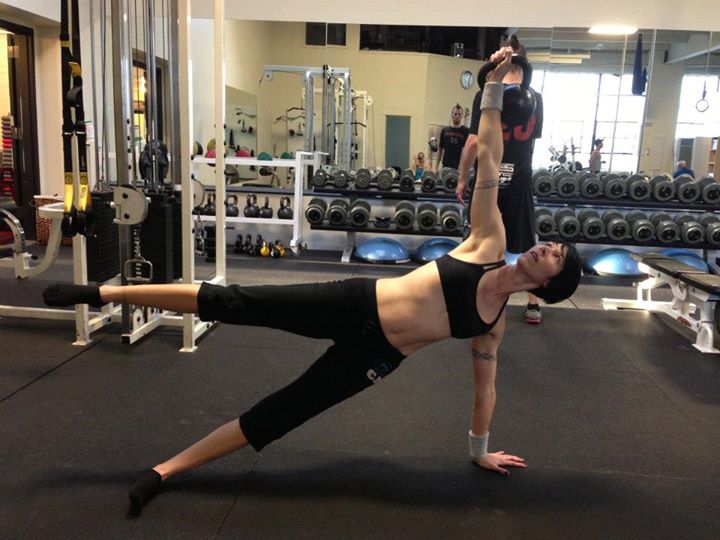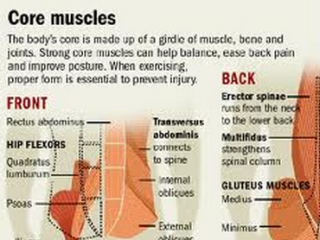
I recently got an email from a high-level ultimate player in Australia asking my opinion on core exercises for ultimate – he said he understood the reason for training rotational core strength and leg-integrated movements, but failed to understand the relevance (if any) of crunches and bridges to ultimate.
First of all, I LOVE getting these emails, keep ‘em comin’. Here’s the long-form answer of my response, and some exercises to add into your program if you’re looking for something new/fun/more ultimate-specific than most of what’s out there.
It’s helpful at this point to agree on the working definition of “the core” – it involves all major musculature between the lower ribs and the upper thighs, 360 degrees.

In order to know how we should train the core for ultimate, we have to look at the demands of the sport and what differentiates the good player from the great player. If you look at film from one of the top players in the game, you’ll notice something – their whole body moves as a unit. You can notice this especially when they change direction…they plant, putting a ton of force into the ground, and their upper body moves with them instead of continuing in the wrong direction. It’s easier to do this on offense (because you’re choosing the timing of your cuts) but its especially important on defense because your reaction time is so important. You can also spot the people that have good core strength by the way they’re able to keep their position in the air, even during contact, and come down with the disc, and layout huge without ending up in a crumpled heap (most of the time, anyway). In short, the core is the integrator, the piece that either powers the engine of your game or lets all your energy leak away.
One of the big mistakes we make with core training is that we treat our core musculature differently than the rest of our bodies. We do a big chunk of core work at the end of a training session when we’re exhausted – is there any other muscle group we would train that way? We do isometric (motionless) exercises like 2 minute planks – is there a time during a game of ultimate when you’re going to be motionless for two minutes? We confuse the word “strong” with the word “tight” – of course we need the core to be strong, but what it really needs is to be stable in certain places (pelvis and low back) and flexible in others (hips and glutes), and it only needs to “tighten,” or be in tension, when we’re using the musculature in the motions of our sport (running, jumping, throwing).
The name for what we need is Reactive Core Training: exercises that teach our core to do what we need it to do, when we need it to do it. When we run/lunge/layout, our core should dynamically engage and act as a loaded spring in the center of our bodies. Springs are flexible AND strong, and the muscles of your core need to learn to work together to enable the most powerful on-field result. The development of that spring-like quality takes time, and you need to train it with exercises that challenge your core in ways similar to the demands on the field. Reactive core training exercises employ sharp, sudden movements with resistance that require equally sudden, powerful stabilization from your core musculature.
I’d like to share my own top three core exercise progressions for ultimate and explain why I think they’re baller. There are literally a gazillion great exercises out there (I’m not including glute-specific exercises on this list for space reasons but here are some ideas), so when you’re exploring on your own and trying to decide which to use for your training, make sure you ask yourself the most important question: how is this movement going to make me a better ultimate player? You should know the answer, because if you don’t, you can do the exercise incorrectly without knowing it and not reap the benefit, or spend hours and weeks getting better at an exercise that doesn’t translate to on-field performance. All these progressions start with the most stable option and progress to the exercise that is the most unstable, therefore requiring the most functional reactive strength.
A couple caveats before I get started: not all of us can jump right in to reactive core training. Many of us have postural problems or poorly-rehabbed injuries that prevent us from activating key musculature in our core. Stuart McGill has a great article breaking down these issues and offering exercise recommendations, and I’ve shared my thoughts about how small changes in structure and activation can improve function. In addition, some of the more advanced progressions I offer require significant plyometric strength – it’s important to spend as little time on the ground as possible to get the most reactive core benefit. Stick to short sets that get you breathing hard, and only add weight if you’re springy!
Prone (Facedown) Progression: Rollouts/Stir-the Pot, Plank Pull and Dynamic Plank
When does it make sense to train facedown for ultimate? When you’re dynamically engaging your core in a way that helps you fix energy leaks in your posture and running form.
Notes:
*Correcting anterior pelvic tilt: If your butt sticks out and you have issues with your hamstrings, focus a little extra on keeping your lower back long, tucking your butt under, and engaging your glutes.
*Increasing pelvic stability: If your hips drop side to side every time you move your arms on the Plank Walkaround (use a mirror or get a friend to watch you), stick with the Plank Variations until you can move your limbs independently without a drop in your hips.
Farmer’s Walk Progression: Farmer’s Walk, Farmer’s Hops, Weighted One-foot Hops
These exercises are great for working on differential core strength – I’ve made the point before that because of ultimate’s asymmetricality, players generally have less core strength and engagement on one side (usually their non-throwing side). This leads to uneven engagement while doing things that are supposed to be symmetrical like, say, running. Also, if your core is weak on one side, you lose energy and therefore power during change of direction. All these exercises develop reactive core strength because you’re in motion – your core has to react and engage every time you move one foot in any direction.
Notes:
*Increasing pelvic stability: Do your hips remain level when you hop forward on one foot, or does your opposite hip drip down? If so, stick to the Farmer’s Walk and keep retesting – adding weight to an unstable pelvis is a recipe for janky groin and adductor musculature!
*Uneven core activation: Try to keep your body straight up-and-down the whole time – don’t allow the weight to pull you over or compensate with any funky body leans!
Cable Progression: Pallof Press, Chop and Lift, Choppy Chop and Lift
You use your upper body in ultimate! Seriously, you do! Stronger arm action leads to being faster and quicker, better shoulder integration helps you box out like a champ and keep your shoulder from dislocating, and your throws are so much more powerful when you use your core and hips to drive them.
Notes:
*Increasing glute engagement: If you find yourself feeling these exercises in your inner thigh, try pushing forward with your rear-leg glute. If that doesn’t help, go back to the first progression (with feet in a line) and work to develop your single leg glute activation.
*Working the right diagonal: With a partner, take turns and do this exercise. If your partner has no problem knocking you forwards, then you need to train the low-to-high diagonal (the “lift”) – if you fall over backwards when force is directed up, you need to train the “chop,” the high-to-low diagonal. This is also a good reactive core warm-up, IMO.
Now, when do you do these exercises, and how much? It depends on the progression you’re working on and how far you are from where you want to be. I think the best place for a reactive core exercise within a workout session is in between sprints and other drills (in addition to, not in place of, actual rest), although you can certainly do them in other workouts as well. I mentioned John Hardy in my last article – during the seminar I attended, he spoke about a cool new tool called the Core Stick (a piece of reactive training equipment he developed). He said he was having runners do a sprint, then 30-45 seconds of a core stick exercise, then sprint again, and he was recording ridiculous improvements in running time. I’ve been experimenting with sprinkling these exercises in between power movements and sprints, and I’ve seen people getting faster/more integrated and powerful the next time they do that exercise. If you’re working on mobility/stability and core strength (i.e. you’re on one of the first two progressions), I suggest slotting them into your strength workouts, between exercises, or at the beginning to aid with core activation before you lift the heavy stuff. Example: one set of Skater Squats, then some Plank Pulls, then try the Skater Squats again – you should feel less wobbly and more integrated.
The one place I wouldn’t put core exercises is at the end, where they can’t positively influence the workout you’re doing and you’re too tired to use the musculature in a way that mimics gameplay. Remember that no matter where you are on the progression chain, the exercise needs to show you the money on the field. Figure out how you’re going to evaluate improvements – brainstorm, ask specific questions in the comments, or email me and ask! In the mean time, no more crunches!! :)











Comments Policy: At Skyd, we value all legitimate contributions to the discussion of ultimate. However, please ensure your input is respectful. Hateful, slanderous, or disrespectful comments will be deleted. For grammatical, factual, and typographic errors, instead of leaving a comment, please e-mail our editors directly at editors [at] skydmagazine.com.